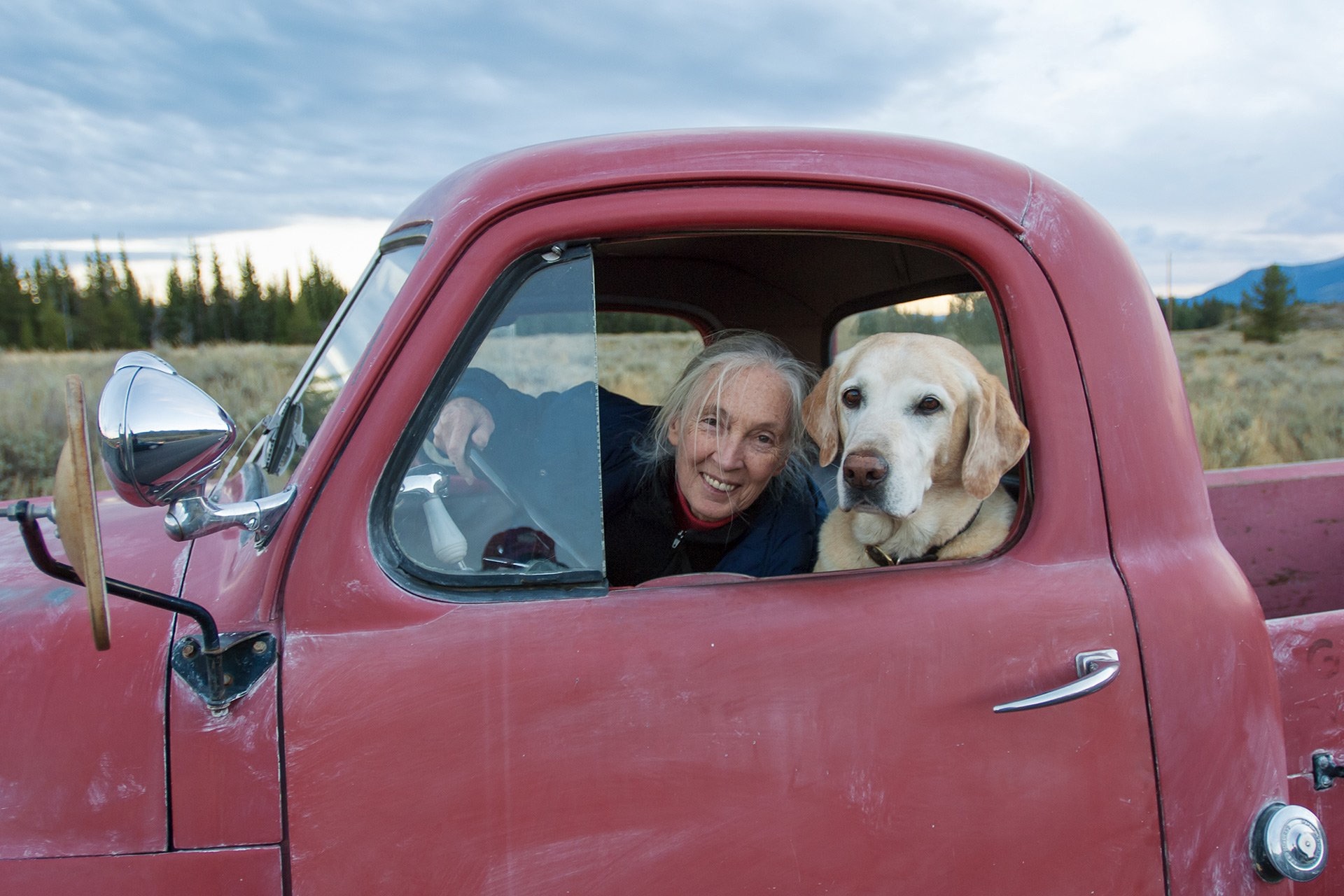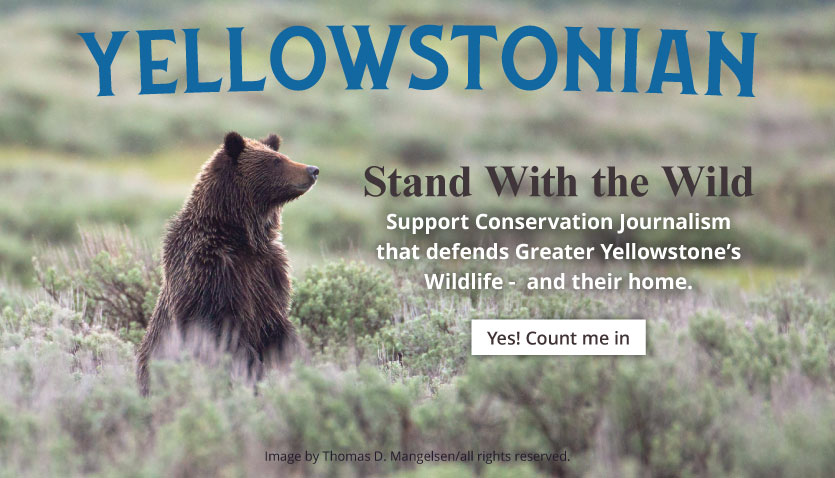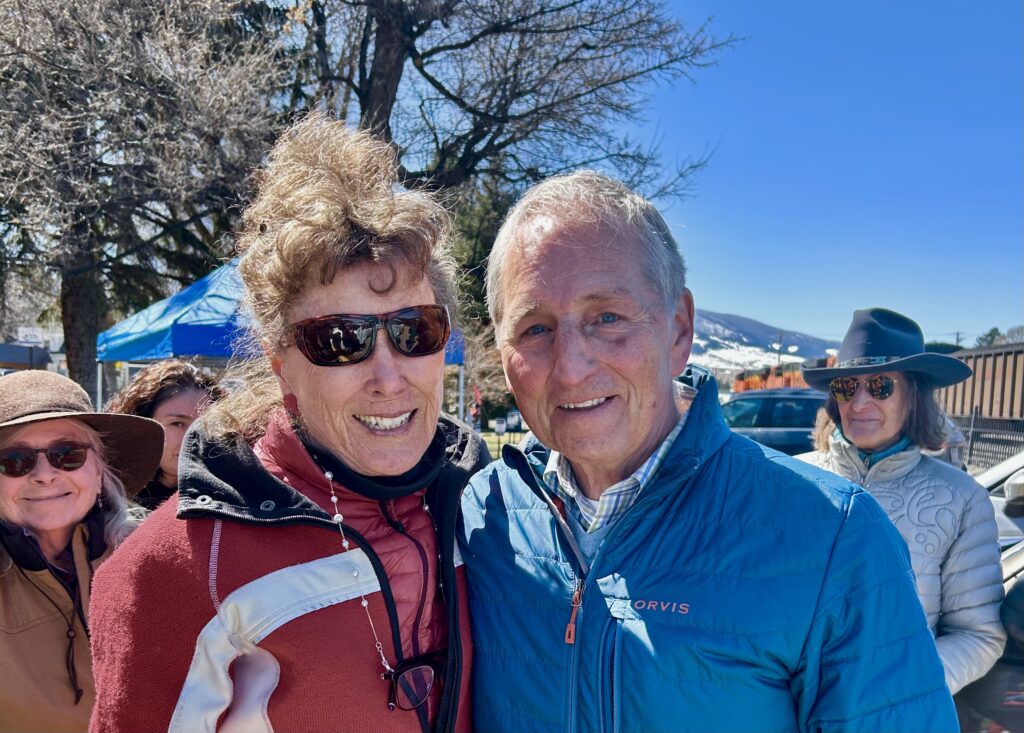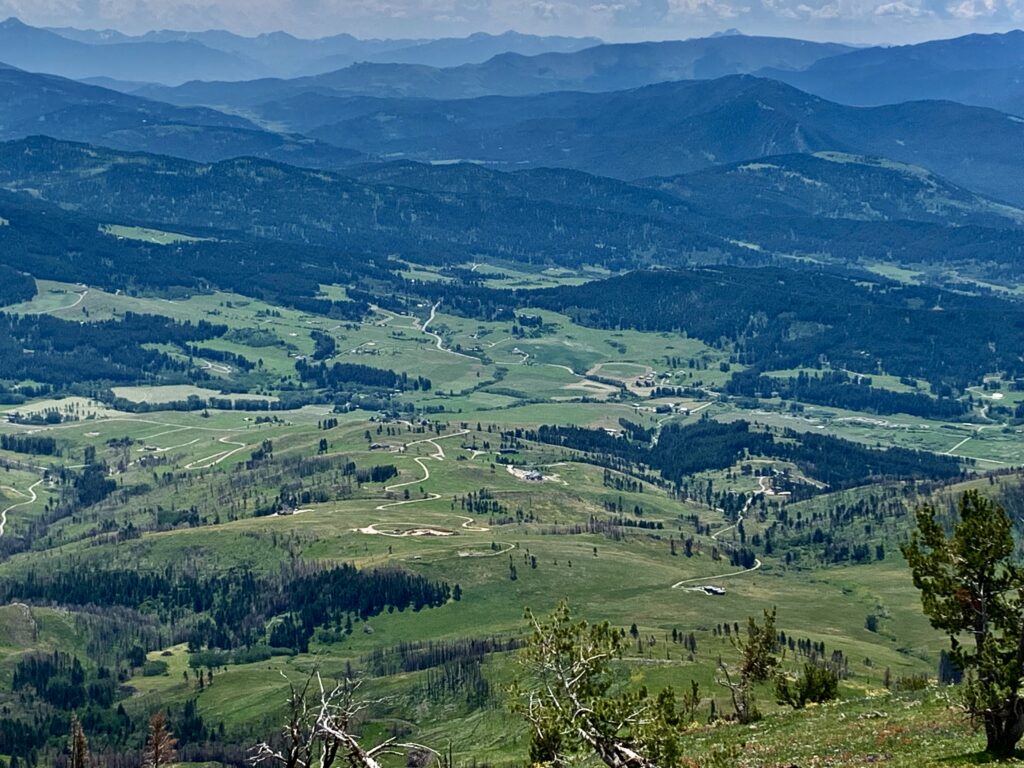EDITOR’S NOTE: Thomas D. Mangelsen is a world-renowned nature photographer who lives near Moose, Wyoming. A dear friend of us at Yellowstonian, Tom will be writing a regular column, A Life in the Wild. In his first piece, he reflects upon the importance of Dr. Jane Goodall, who just turned 90 years old, counts Greater Yellowstone among her favorite wildland places on Earth. Goodall has spoken out on behalf of Jackson Hole Grizzly 399, wolves and mountain lions and she’s been a regular visitor to Jackson Hole. Mangelsen, below, shares the story of how their deep friendship began when he took Goodall on her first-ever trip to Yellowstone. Of Mangelsen, Goodall told me, “Tom has a passion for saving the wilderness. He’s not going to give up this fight. And because of his gift of photography, he is creating awareness in thousands of people might never otherwise have been aware.” —Todd Wilkinson

Who are the next fearless heroes of wildlife conservation? After the great elders, who have inspired generations of advocates pass on, who will take up the mantel?
I’ve heard it said recently that young people in the Greater Yellowstone Ecosystem are more passionate about having their outdoor playtime than they are willing to take a stand.
I pray it’s not true. No generation is a monolith and understanding the importance of conservation comes with time and perspective. But the truth is we need their advocacy for the wild Earth now because we can’t wait until they reach middle age.
I just want to remind that the senior citizens we praise today were once young, just as members of GenZ and Millennials are now. Their predecessors, who were scientists, businesspeople, ranchers, outdoor recreationists, artists and employees in government didn’t speak out for wildlife because they courted fame. Often, they started with no plan, merely following their instincts and affection for non humans. Fueled by passion and a conviction in knowing what’s right and wrong, their willingness to fight the good fight gave them accrued knowledge, experience and the thing all of us seek: perspective. Greater Yellowstone is a region where many of the most seasoned advocates on Earth have had epiphanies.
It would be hard for any of us to imagine being one of the most notable—and beloved—human faces of wildlife conservation on Planet Earth. But this is the bright light we have in Dr. Jane Goodall who, in April 2024, reached her 90th birthday. Remarkably, Jane shows little indication of slowing down, just as my friend, the late Margaret E. Murie (Mardy) of Moose continued to lead as a centenarian.
Fortunately for us, Jane believes, as Mardy and contemporaries before her did, too, that the cause of keeping Greater Yellowstone’s wildness intact, on behalf of the animals who call it home, is one of the noble causes of our time.
Fortunately for us, Jane believes, as Mardy Murie and contemporaries before her did, too, that the cause of keeping Greater Yellowstone’s wildness intact, on behalf of the animals who call it home, is one of the noble causes of our time.
Jane is teaching by example showing that when it comes to giving back to the world in a meaningful way—and, for me, thinking about our potential to harness the insight, wisdom, and virtues of our elders is a reason why I have hope.
I count Jane among my closest friends. Her fearless determination to give a voice and bringing respect for other species is infectious. I’ve had the pleasure of joining her in the field at several locations, including Gombe Stream Preserve in Tanzania where her game-changing research into chimpanzee behavior began. She, after all, has demonstrated that conservationists, who are not white males, need not ask for permission to show how purposeful advocacy is done.

As a young woman in search of her own direction, Dr. Jane Goodall, an Englishwoman from the seaside town of Bournemouth, spent 60 years in Tanzania observing and studying chimpanzees in their natural habitat. Her groundbreaking research on chimpanzee behavior and social organization revolutionized our understanding of these fascinating primates and paved the way for further research on animal intelligence and behavior. It’s one of the reasons why Jane has become such an outspoken advocate for Jackson Hole Grizzly Bear Mother 399. She sees parallels between the battle to spare primates like gorillas and chimpanzees from being hunted and poached and the remarkable sentient wild grizzlies we have in Greater Yellowstone. The recent event in Sublette County, Wyoming, involving a snowmobiler who chased down a wolf and tortured it before killing it leaves us both sad and appalled.
Jane’s public presence represents the quintessence of grace, conviction, tenacity, and, when required, even feistiness, in inspiring us to safeguard the last great wild places which, of course, are the final homes of so many species. But I’ve also had the good fortune of enjoying Jane’s more personal side. She still carries with her a boundless sense of both curiosity and optimism which converge as humility. She still considers herself a perpetual student of Mother Nature whose lessons would take many lifetimes to learn. Again, of any region in the Lower 48 of the US, she believes Greater Yellowstone is perhaps the best example of why wildlife conservation matters.
For many of us, we became aware of Jane and her work with chimps through TV specials in the 1960s and feature stories written about her work with chimps through the pages of National Geographic magazine. The late Craighead brothers, John and Frank, who pioneered the study of grizzly bears in Yellowstone and were based in Jackson Hole, also were featured in NatGeo. I knew them quite well.
With Jane, I’ve witnessed her exuberant spirit while watching Sandhill Cranes together at my family’s cabin in Nebraska along the Platte River and, of course, during visits to stay at my place in Jackson Hole. She is today, notably, counted among the most vocal defenders and allies of Grizzly 399. That ought to be sending a message to Wyoming Gov. Mark Gordon, members of the state legislature and our Congressional Delegation who are pushing to have Wyoming and neighboring states take over management of grizzlies, so that they can be hunted for sport and fun. I agree with Jane when she reasonably asks, “Is the primary reason we rescue species from the brink so we can turn them into rugs and trophies? As a sapient species ourselves, aren’t we better than that?”
On the occasion of Jane becoming a nonagenarian in early April, I’d like to share the story of how our friendship began. Appropriately, it involves an outing we took to Yellowstone. It’s amazing to be able to say that for all she has seen and given all she has done as an advocate for preserving biodiversity and recognizing sentience in non-humans, Jane herself recalls her first trip to Yellowstone as one of the most memorable of her long career.
Around the turn of this new millennia, amid her nonstop travels, she made a pitstop in Jackson. Her reputation obviously preceded her. For many years I had been a big fan of both her and her former husband, Hugo van Lawick, one of the greatest wildlife photographers and filmmakers of all time.
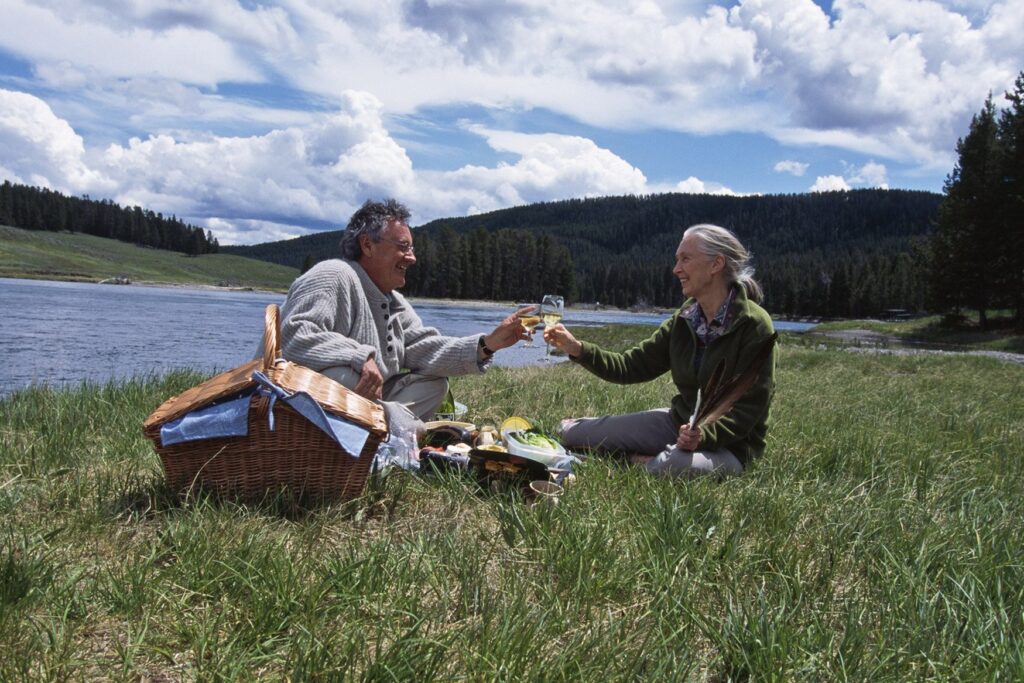

Our introduction happened like this: I had been invited by a mutual friend to introduce Jane at a lecture sponsored by the National Museum of Wildlife Art. Our trip to Yellowstone resulted from a stop she made earlier at my art gallery in downtown Jackson. As luck would have it, she had a rare free layover day and I was tapped to serve as her guide in visiting a park that loomed large in her imagination.
As we drove north towards Yellowstone, I asked Jane what she would like to see. “I want to see everything,” she said.
I found her boundless enthusiasm inspiring yet daunting. How could Yellowstone possibly live up to her lofty expectations? Riding in the vehicle next to me, after all, was a passenger who had already witnessed so many extraordinary wonders in the natural world. I did not want to let her down.
I decided to try and narrow our options. “Have you ever seen wild wolves and grizzlies?” I asked.
To my surprise, she hadn’t.
Yellowstone, and the larger ecosystem enveloping it, is vast but not large enough to sustain healthy populations of wildlife by itself. It is never wise to be hasty. Fortunately, we got an early start, giving us the best chance of seeing wolves and reaching Yellowstone’s Lamar Valley in the distant northeastern corner of the park—a four-to five-hour drive without stopping.
“How much time do you have?” I asked. “As long as you get me back in time for my flight out of Jackson Hole at 9:30 tomorrow morning, I’m good to go,” she said.
I realize, upon reflection, that Jane carried with her the same kind of unformed excitement that most people do, no matter what their age, when they are pondering a trip to our premier national park.
I realize, upon reflection, that Jane carried with her the same kind of unformed excitement that most people do, no matter what their age, when they are pondering a trip to our premier national park.
Our first stop was at the Oxbow Bend of the Snake River, which has the highest biodiversity of mammals and birds in Grand Teton National Park. It’s not only my favorite place in the Lower 48, but also a nearly guaranteed spot to see something interesting. Upon pulling over at Oxbow, we immediately identified several species of ducks (American mergansers, Barrow’s goldeneyes, and mallards), a few white pelicans, Canada geese, a bald eagle, and an osprey attempting to catch trout near the water’s surface.
Jane grabbed her binoculars and quietly observed the osprey’s fishing technique of hovering and diving with outstretched talons. Knowing that we had a long day ahead, I tried to gently encourage her to continue our journey, but she wanted to savor every moment in an unharried way. Jane Goodall didn’t become Dr. Jane Goodall, who spent 60-plus years studying our wild primate cousins in one of the longest continuous research projects of any wild animal, by being in a rush.
We carried on northward to Yellowstone. After entering the park’s South Entrance, we traveled through about 25 miles of mostly lodgepole pine forest that had been ravaged by the great Yellowstone fires of 1988. More than 800,000 acres—around 36 percent of the park—had burned. Although the blackened forest was still visible, thousands of young green saplings had emerged. It was a grand example of one of Jane’s reasons for hope, what she calls the “resilience of nature” and its ability to rejuvenate.
We continued our way, making several stops to stretch our legs and scout for more wildlife on the shore of Yellowstone Lake and along the path of the Yellowstone River leading into Hayden Valley. At Fishing Bridge, an amazed tourist motioned toward us and said, “Is that really Jane Goodall?” I said yes, and the woman asked if it would be possible to get her autograph.
When I asked Jane, she responded, “Yes, of course, but wait a second.” Then she reached into her bag and pulled out a brochure for the Jane Goodall Institute (JGI). She walked over to the woman’s car window and said she’d be happy to provide an autograph—as long as the tourist promised to become a member of the JGI and Roots & Shoots, her conservation organization devoted to public education of youth and habitat protection for species around the world. The excited woman said, “Of course!”
How clever, I thought, marveling at Jane seizing the opportunity to enlist another citizen in the cause of giving a voice to wildlife.
It was an auspicious moment. Soon, we saw a huge, gorgeous male grizzly feeding on grass near Fishing Bridge. The bear, paying no attention to us, crossed behind the Land Cruiser to the opposite side of the road. It grazed and slowly meandered up the road. We jumped out of the car when the grizzly was far enough away and Jane, with her small video camera, began documenting the great bear.
As she moved in front of the car, it struck me that here was Jane Goodall, one of the most important people working to protect the planet, enraptured by Yellowstone. I felt a bit overly cautious about her and the bear. My mind focused on the fact that I had not only the gift of spending the day with Jane but also the incredible responsibility of protecting her. And it wouldn’t look good on my epitaph if it were to read that Jane Goodall got mauled on my watch!
“Be careful, Jane,” I said in a soft voice. She turned to me and replied, “Oh Tom, this bear is fine.” Of course! Jane understood animal behavior far better than anyone. I relaxed.
As the bear disappeared over the hill and we returned to the car, I explained the rarity of the experience we had just had. I had never seen a grizzly anywhere near Fishing Bridge. After she said “The Buddhist monk brought us the bear,” I was intrigued. She told a story of how she had recently met a Tibetan monk who was sitting next to her on a flight. She described his traditional orange robe and how they talked for a little while before he reached into his satchel and pulled out a Tibetan edition of her book My Life with the Chimpanzees and showed it to her. Their encounter, and Jane’s remark about the monk bringing us the grizzly, made me realize I was experiencing what I later learned was called “Jane Magic.”
At Buffalo Ford along the Yellowstone River, we stopped for a picnic. Jane didn’t want to sit at a picnic table; she wanted to sit on the grass where she could feel the earth beneath her.
“Let’s go down there,” she said, pointing to the meadow along the river’s edge. We talked about many things, including our childhoods. I had learned some details of her upbringing through her books, but she shared much more that I didn’t know. At that time, she was 67 and I was 55 years old. I soon realized this was a Jane not a lot of people got to experience and felt very honored.
When I was talking about growing up in Nebraska, Jane asked if I knew anything about the great sandhill crane migration. “Yes,” I said, and it just so happened that I had filmed or produced three films about cranes and that my family had a cabin on the Platte River in the middle of the migration flyway. Beyond the more than half-million cranes, millions of snow geese and other waterfowl also migrated to the Platte during March. “What are you doing in March?” I asked. And Jane replied, “I’m going with you to see the cranes!”
During most of these past couple of decades, Jane has come to see the cranes with me. As mentioned earlier I also have been to the chimpanzee preserve of Gombe with her, and we have met in many other places.
Jane spent a month with my lab, Loup, at my cabin adjacent to Grand Teton National Park to write a book while I was in Brazil photographing jaguars. Afterward, she said, “Those 30 days were the longest period I have been alone in more than 20 years!” I was stunned but so happy for her and for Loup, one of her favorite dogs, who received much attention and retrieved many balls out of the pond. Our close friendship is based on our mutual bond over nature.
In Yellowstone that day, we gazed into the Grand Canyon of the Yellowstone, traveled over Dunraven Pass, and then arrived in the Lamar Valley at Pebble Creek, hoping to see the wolves that had been reintroduced to the park a half decade earlier. We didn’t see one. The light was starting to fade, and it would be at least a four-hour drive back home. I was disappointed not to have shown Jane a wolf, but we still had a chance on our way back through the valley.
Some 20 minutes later, we noticed a dozen people standing along the road, looking through spotting scopes at the far hills. I knew these were citizen wolf watchers. We stopped and joined them. As Jane peered through one of their scopes, she saw a black wolf on the far side of the river a half mile away. And just above the wolf was a grizzly grazing. We found a wolf and the second grizzly of the day. It started to rain and we headed south toward home.
On the way, we saw a black bear mother with three cubs along the far shore of Rainy Lake. In all my years of going to Yellowstone, I’d never seen grizzly bears, black bears, and wolves on the same day. Jane Magic, indeed!
On that first outing in Yellowstone, Jane and I missed many of the park’s most famous geothermal features, like the eruption of Old Faithful, the steaming geyser basins, the mudpots, and the colors of Grand Prismatic Spring. Those waited for other times and visits. Jane has said she can never get enough. Yellowstone is simply too big, beautiful and intricate to experience fully in a single day, week, year—or lifetime. Like us, she is Mother Nature’s student, and one of her star pupils.
Subscribe
Never miss a story, subscribe to our newsletter!

